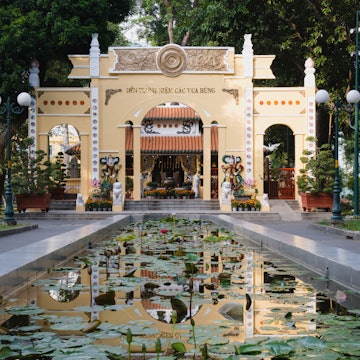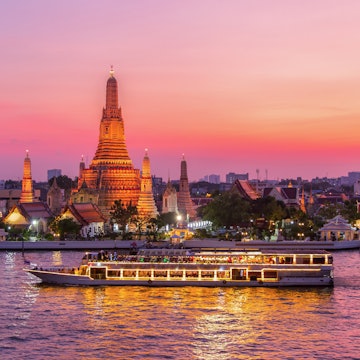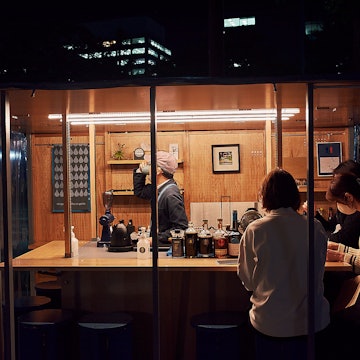

Street food in Ho Chi Minh City, Vietnam. James Pham/Lonely Planet
Vietnam all but guarantees a memorable trip, whether you’re living it up like royalty or scrimping on a shoestring.
Once you’ve covered the cost of getting here, you can explore for under US$40 a day, staying in dorms and eating pho (noodle soup) and banh mi (baguette sandwiches). Or you go all out by staying at luxurious heritage hotels, booking exciting adventure tours and indulging in banquet dining.
Either way, you’ll get your fill of fabulous food, colorful cities, complex cultures and luscious landscapes in one of Asia’s most captivating corners.
The most important principle? How much you spend is largely within your own control. If you’re happy with a dorm bed, bus travel and street food dinners, the basic costs of living in Vietnam will not make a massive dent in your wallet. But if you crave creature comforts, organized activities and top-end dining – or hire a car and driver to get around – your costs will climb steeply.
Since we imagine you fall somewhere in between these extremes, consider our creative tips for getting the most for your money when visiting Vietnam.
1. Time your trip right to save
Vietnam gets a soaking from the southwest monsoon from May to September and the northeast monsoon from October to April, making the country – and the regions within it – highly seasonal destinations. Prices for domestic flights and accommodations soar when the weather is good, and descend when the skies open – but since the climate varies as you move around the country, you can usually find somewhere to explore even at the height of the rainy season.
Flight prices peak during July and August, coinciding with the warmest weather on the central coast. There’s another peak from December to March, when many visitors head to Phu Quoc Island and the hiking trails of the northwest. Watch for more price spikes associated with local holidays such as Reunification Day on April 30, International Workers’ Day on May 1 and the Tet lunar new year celebrations in January or February, when it can feel like the whole country is on the move.
2. Fly into Ho Chi Minh City (HCMC) rather than Hanoi
Ho Chi Minh City (HCMC) has the biggest and busiest airport in the country; more flights mean more competition, and frequently cheaper fares than those to Hanoi in the north. You should keep in mind that HCMC is a higher-cost city – meaning any savings can quickly be eaten up if you stay too long in the former Saigon. Craft your itinerary accordingly.
3. Come into Vietnam the back way
You don’t need to arrive in Vietnam by plane, for the country has easy land-border crossings with Laos, Cambodia and China. Keep an eye out for promotional deals on flights to smaller Chinese cities such as Guangzhou and Shenzhen, which offer connections to northern Vietnam by bus or train via Nanning, crossing the border at Lang Son. (While these options may cost less than plane tickets, count on much longer travel times.)
If you’d rather come in from the south, consider flying into Thailand and traveling overland across Laos or Cambodia. The route from Bangkok to Phnom Penh and on to HCMC is a backpacker favorite.

4. Seek out lower-cost, independent adventures
Vietnam is a giant playground for adventurers, yet organized tours and adventure activities can consume your travel funds quickly. For cheaper thrills, bring your own snorkeling gear, use public ferries rather than boat tours, and rent a bike, motorcycle or scooter to explore under your own steam rather than taking a tour.
If you’re here to hike, seek out trekking routes that you can follow without joining an organized expedition, such as the trails on Cat Ba Island or walks to the minority villages near Bac Ha in the far northwest. Many homestays can arrange an inexpensive guide for local exploring: this is usually cheaper than booking an agency tour, and it funnels money directly into the local economy.
5. Take the “open tour” bus
You won’t get a lot of cultural immersion on an “open tour” tourist bus. Yet taking the road more traveled can save you time – and time, as every traveler knows, is money. While fares for these tend to be higher than for ordinary buses, you’ll know exactly what you are getting – and you won’t have to bargain to pay the correct fare.
Services start and finish in town centers rather than at the bus stand, saving you a taxi fare at either end of the trip. Plus, many long-distance routes run overnight, saving you the price of a hotel room. You’ll also cut out the minor stops that can slow long-distance bus travel to a crawl.

6. Travel from place to place overnight
Budget flights can be very affordable in Vietnam, but you’ll have to balance any money you save against the cost in carbon emissions. A better way to save is by traveling overnight. For longer trips – such as the journey from Hanoi or HCMC to Hoi An or Nha Trang – a sleeper bus or train will save you the cost of a night’s accommodation, without eating into your valuable daylight sightseeing time. Reclining seats and horizontal berths are available on both trains and buses.
7. Make the most of hostels
Hostels were once rare in Vietnam, but these days they’re popping up everywhere, including sleek flashpacker hangouts such as Hanoi’s Nexy Hostel and HCMC’s Hideout Hostel. You can even find hostels with on-site bars, restaurants and swimming pools. Some hostels offer private rooms as well as dorms – though if you crave your own space, private rooms at ordinary budget hotels may cost less.
8. Head for a homestay in the hills
You’ll find plenty of good hotels in Vietnam’s emerald hills. But if you’re looking for an experience that’s both more cost-effective and more authentic, opt for a village homestay. In the Mekong Delta; the Central Highlands; the Cham Islands; and in such quieter corners of the northwest as Mai Chau, Ba Be and Moc Chau, you can get a simple but comfortable room and a deep immersion into local life for a modest price. The best part? Blistering home cooking is often part of the package.

9. Eat on the street
Street food is the lifeblood of Asia, and Vietnam is no exception. For an astonishingly reasonable price, you can expect to feast on everything from pho soup, banh mi sandwiches, banh xeo pancakes and bun cha (grilled pork with vermicelli noodles), to the tongue-twirling flavors of banana flower salad and bo la lot (skewers of beef grilled in betel leaves).
At lunchtime and in the evening, street eateries set out plastic tables and chairs on the pavement, giving you a perch while you munch. Night markets and busy transport hubs offer the richest pickings.
10. Watch out for “optional” extras
From mom-and-pop eateries to swanky restaurants and hotels, you'll often see extras on the table – tissues, bottled water, moist towels, peanuts – but don’t assume that all these items are complimentary. Costs for these are actually minimal (usually 15–20 cents for a moist towel or 50 cents for the peanuts), but it can all add up. Check your bill carefully and let the wait staff know if you've been charged for something you haven't used.

11. Hone your bargaining skills
Some travelers complain about being overcharged in Vietnam. But since bargaining is part of the culture here, we recommend coming prepared to haggle away. Remember to treat such exchanges as a game, and your counterparties with respect; negotiating a suitable price is not a moment to flash anger. If you think the price is too high, come back with a lower counteroffer and see how the seller responds. With a bit of give and take, you should reach an arrangement that is mutually acceptable.
Before taking public transport or hailing a taxi or rickshaw, ask your hotel or guesthouse about the price to get a sense of what you should be paying. Never let the haggling process become confrontational – everyone has a right to make a living, and you may be arguing over a tiny sum of money that makes a bigger difference to the vendor than to you.
12. Don’t linger too long in major cities
Hanoi and Ho Chi Minh City are significantly more expensive than other parts of the country. Use your sightseeing time in these huge cities strategically – prioritizing essential sights and street food – before moving on to calmer corners where your dong will go much further.
Of course, one reason Vietnam’s two largest cities are so expensive is the sheer variety of things to see, do and eat there. If you can resist the temptation to take in everything, it’s still possible to enjoy Hanoi and HCMC on a modest budget.

13. Prioritize the free sights
Entry fees to Vietnam’s excellent museums – which often take an unflinchingly honest look at the history of the American War – are generally modest and well worth it. Still, many of the country’s fascinating pagodas, temples and cathedrals are completely free to visit, and there’s no charge for checking out Vietnam’s striking colonial-era architecture from outside.
For temples, take your pick from the heirloom monuments of Hanoi, Hue and HCMC, or modern marvels such as Chua Bai Dinh near Ninh Binh. For relics of French colonial rule, concentrate on HCMC, Dalat and Hanoi.
People-watching at markets is always free, so get your fill of brilliant bazaars such as Ben Thanh Market in HCMC and Dong Xuan Market in Hanoi.
14. Save on downtown transport
Metered taxis in Vietnam are very affordable by global standards. Unfortunately, some drivers in tourist areas refuse to use the meter, and we hear regular stories of meters being rigged to ramp up fares. If you take cabs, rides booked through the Grab app tend to be cheaper than taxis hailed in the street, and you'll know exactly how much you'll be paying before you step in.
Even if you’re paying the right fare, costs for taxi travel can quickly add up, so save money by exploring on foot, renting a bicycle or taking local buses. Just watch out for pickpockets on crowded buses at busy times.

15. Drink bia hoi
A big night out in the hip bars of Hanoi or HCMC can take a big bite out of your travel budget, as well as leave you with a monster hangover. By sticking to bia hoi – Vietnam’s gently alcoholic, homemade draft beer – you may be able to avoid both of these inconveniences.
Costing significantly less than bottled beer, this agreeable brew is normally quaffed at plastic stools on street corners, often with some light eats to keep the conversation flowing. Track it down everywhere from Dien Bien Phu to Cat Ba Island, but particularly in Hanoi.
Daily costs in Vietnam
Hostel dorm bed: US$5-10
Basic room for two: US$10–20
Village homestay: US$5–20
Room at a beach resort: from US$80
Local bus ticket: from US$1
Cup of ca phe (drip coffee): US$0.70
Banh mi sandwich: from US$0.70
Sit-down dinner for two: US$15
Bottle of beer in a bar: US$1
Glass of bia hoi (local draft beer): from US$0.30
Average daily cost for budget travelers: US$40–70
















